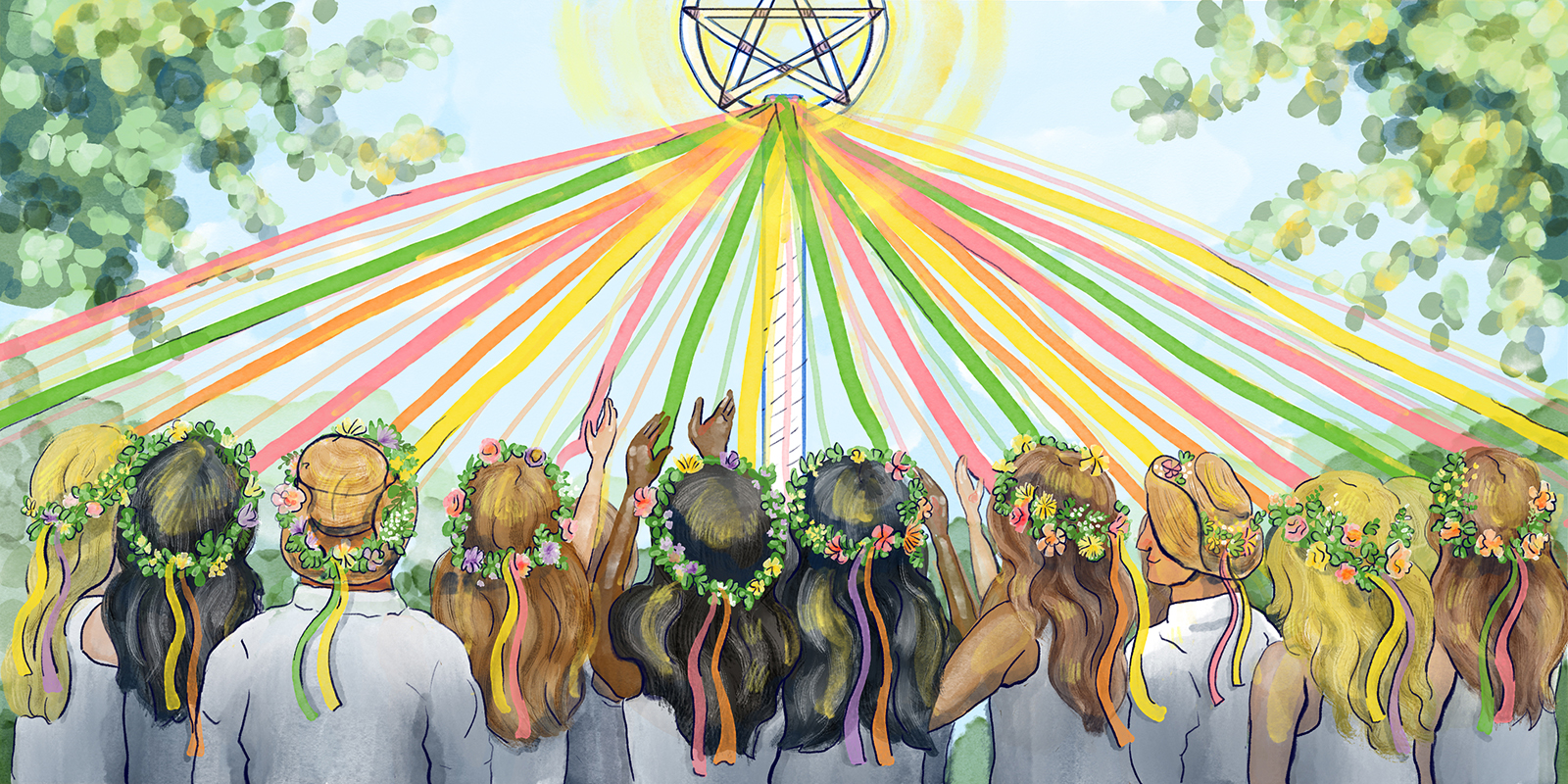

My last Wicca 101 class started like all its nine predecessors — a disorganized mess of mixed messages, strong personalities, and confusing directions (attributes amplified by our virtual classroom). I had looked forward to tonight’s topic, rituals, from the moment I first scanned the syllabus after finding the course online in a pandemic-fueled need for some nature-informed spirituality and to act on my curiosity about Paganism. But unlike the previous classes, I logged onto Zoom with confidence. I knew standard Pagan rituals possess a minimum of three parts — the opening, the working, and the closing — and are used for spiritual growth, magick (a term used to distinguish this practice from rabbits-out-of-hats “stage magic” and the likes of David Blaine), and spellwork. Rituals also help celebrate the holidays and rites of passage and to commune with Deity.
But as I joined the group, familiar faces along with the familiar chaos began to populate my laptop’s screen. High Priestess (please note: the two teachers and four classmates will be referred to by their given titles or by their most prominent attributes) shared the plan, starting with a change in procedure — Smoker would say Bandana Girl’s lines in addition to her own since Bandana Girl felt too sick to participate. I regretted that Bandana Girl beat me to the sick card. Then, High Priestess told us to begin, and my confidence evaporated as everyone but me started walking in a circle clockwise. Based on previous classes and discussions about ethics, I thought the virtual nature of our experience precluded us from physically performing the ritual.
Just last week, High Priest explained that no one should do a ritual just for the sake of doing a ritual. And as ours began, his ritual pronouncements pinged in my head:
Have a purpose. Have a reason to do it. Put thought into doing it. If you're not into it or you don't have anything to work on or you're not in the mood to draw down, then don't. And don't go into ritual half assed. If you have a ritual planned that night, and you've had a shit day, don't do it.
I remember laughing when he said that. Between being on the brink of a mental breakdown thanks to the pandemic forcing me to return home to live with my parents, and getting maybe three hours of sleep every night to ensure I maintained my 4.0 GPA, every day felt like a crap day. That’s why I needed a little magick in my life.
And tonight, I arrived prepared, ready to say my lines and call it a night. But I was wrong, very wrong. So I decided to wing it. To save myself from embarrassment, I turned off my camera. Standing in the middle of my room staring at my computer, I felt the beginning of a panic attack.
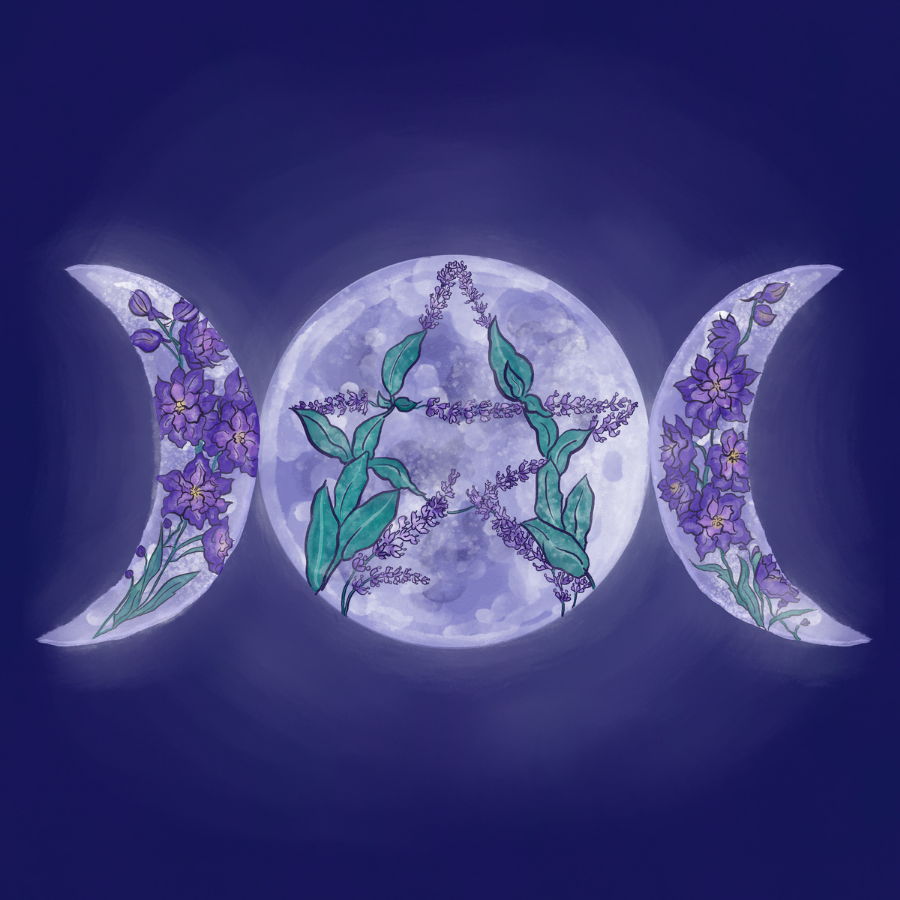
“Jenna,” Smoker said, bringing me back to reality. “Jenna!”
“Oh, am I supposed to go?” I asked.
“Yes!” everyone screamed. “We’re losing the connection.”
Fuck. After Smoker cast the circle, we called upon the Guardians of the North, East, South, and West, invoked the God and Goddess, thanked and released the God and Goddess, and thanked and released the Guardians of the North, East, South, and West. Before we closed the circle, High Priest asked if we’re going to perform any magick.
“No,” Smoker said.
“Oh, okay,” High Priest replied.
After we finished, I turned my camera back on so that we could discuss what we did right and wrong.
“Oh good,” High Priest said. “Jenna’s back.”
Unfortunately, I think to myself. But great news! High Priestess pronounced it “a beautiful ritual.” But bad news! We failed to do a magickal working, aka the meat of the ritual that often includes a poetic invocation, a special prayer, or an additional consecration of some item that gives the set of actions purpose or meaning. So basically, we performed the ritual for no reason.
Maybe I should have left my rule-abiding, 4.0 attitude behind when I signed up for this class. But I really wanted to learn how to be a proper Pagan. In fact, it wasn’t until one of my friends asked if I was a Pagan that I realized I was engaging in many Pagan practices. I felt drawn to its respect for nature, its empowerment of the individual (especially women), and all the interesting stuff (charms, potions, and divination) before I even connected my interests to the practice. The Covid-19 pandemic gave me the opportunity — and the need — to explore my spiritual side. I taught myself about the magickal properties of candles, crystals, herbs, oils, and astrology as well as how to read tarot and oracle cards and use voodoo dolls, pendulums, and spirit boards. But it all felt a bit DIYish.
To learn more about Neo-Paganism, I decided to take an online Wicca 101 class. Held on Thursdays at 7:30 p.m., the course spanned 10 weeks and cost $15 per class or $120 if paid in full before the first class. Each class lasted approximately 45-60 minutes. Once I signed up to take the course, I received an emailed handout each week pertaining to the topic of the night and the Zoom link. Over the course of our time together, we learned about theology/pantheons, Wheel of the Year, tools, etiquette and ethics, and grounding and centering, basic meditation, energy work, and ritual construction.
Facilitated by High Priestess and High Priest, there were five students total: me, Headset Girl, Bandana Girl, The Celtic, and Smoker. With a square face, long red hair like the Scarlet Witch in the Marvel Cinematic Universe, and glasses, High Priestess led the class with her husband, High Priest, a scrawny man with an oblong face, short brown hair, and big ears, chiming in here and there. And thank goodness for that. I wouldn’t have lasted 10 full classes of just High Priest lecturing. A few times, I contemplated shutting off my computer mid-Zoom and pretending my computer died because I couldn’t handle his tangents and ramblings. When he reached peak animation, High Priestess would scooch a few inches away from him on the couch to avoid being hit with his hands (their relationship seemed dysfunctional at best). I adored High Priestess. She gave all of us her number and reminded us to reach out if we had any questions.
My classmates also possessed a few quirks and eccentricities. Zooming in from her bedroom and sporting a gaming headset, Headset Girl was in her late teens and the most social of the group. She enjoyed stirring up lighthearted conversations at the beginning and end of each class. For the first class, she guessed everyone’s zodiac signs and was right about everybody but High Priest. Bandana Girl often zoomed in from her bedroom wearing a colorful bandana. She was also in her late teens and mostly kept to herself, constantly taking notes. The Celtic would join class from his living room couch. He was in his late forties and demonstrated notable knowledge about Celtic paganism. Part of the reason why he joined the class was to deepen his connection with the Deity Morrígan. Smoker would often log on from her car or up against a brick wall outside of her house. She was in her early forties and always overshared intimate details of her life. She also never muted herself, forcing everyone to endure the sounds of shuffling as she smoked. The Celtic and Smoker asked the most questions. They also used their phone or iPad to Zoom, and the rest of us used our computers. So whenever The Celtic and Smoker spoke, all I saw was their pixelated faces from unflattering angles with huge black bars on either side of them.
I longed to find a spiritual escape from the Catholicism of my youth and a balm for my soul during the pandemic.
When the first class rolled around, I quickly realized that I possessed the least experience with the practice. The tsunami of information and my constant confusion about the details of the lecture meant I rarely understood much, including classmates’ questions, and my bafflement rendered me uncharacteristically quiet. It also altered the experience for me. Rather than an engaging dive into a spiritual pursuit that interested me, it felt like my math-averse self was sitting in advanced calculus. If I stopped paying attention for just one minute, I would be lost for the remainder of the class. Then again, even when I gave the class my full attention, I still felt confused when I logged off. Part of the problem, I soon realized, was there’s no wrong way to be a Pagan; every Pagan embraces a different practice and embraces a different opinion on things.
“If you ask five Wiccans the same question, you're going to get five different answers,” High Priestess said. “Six different answers,” High Priest interjected. “Because somebody’s going to change their mind when they’re talking.”
While the other four students laughed, I thought: how frustrating.
In my first class, I learned that Paganism serves as an umbrella term that encompasses many traditions, including Wicca and Witchcraft. Also referred to as Contemporary Paganism, Modern Paganism, or Paganism, Neo-Paganism encompasses a variety of Earth-based religions and spiritualities based on practices informed by pre-Christian or non-Christian forms of worship. Many Pagans start out as solitary practitioners and choose to stay that way while others join a group, often referred to as a coven. “About three-quarters of contemporary Pagan practitioners are solitary,'' says author, sociologist, and resident scholar at Brandeis University Helen Berger. “The biggest group are those who are doing their own form of Paganism.” Those who practice however they choose through the combination of any and all traditions are known as eclectic.
Neo-Paganism is rooted in ancient religious practice but is relatively new. And although the origins of Wicca can be traced to Gerald Gardner in 1954, many experts trace the immediate roots of Neo-Paganism to the late 20th century, stemming from the 1960s American counterculture and 1970s feminist and environmentalist movements.
Derived from the Latin paganus, the term Pagan initially described a person of locality. In ancient Rome, those who lived in the country were considered Pagans. After Christianity became the dominant religion in the Roman Empire, the word served as a religious designation to refer to people who followed the old religions.
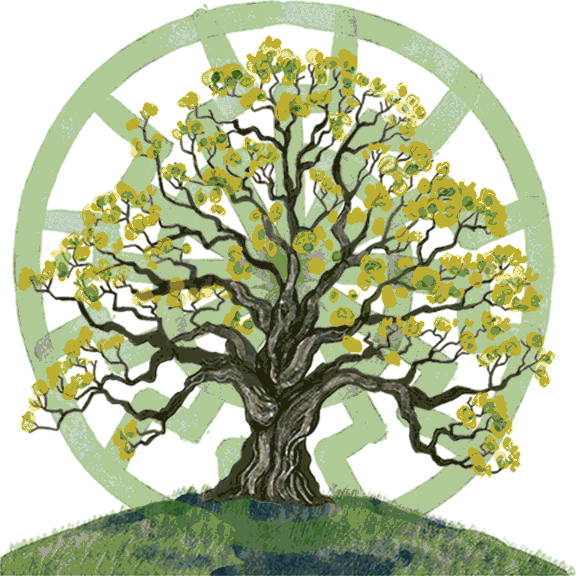
The stereotypes and stigma that surround Paganism in the modern world come from several sources. “America is a Christian majority country, so there's automatically a distrust of non-Christian religions,” says author and professor of world history at SUNY Orange Michael Strmiska. Secondly, “new religions in general in this country and other developed countries are looked at with suspicion,” Berger says. As a result, “there's either been a tendency to trivialize what they do or to demonize it,” says Sarah Pike, author and professor of comparative religion and humanities at California State University, Chico. Christianity’s concepts of good and evil and spiritual warfare as well as compatibility with secularity and science also inform this perspective.
“Paganism, the word, summons up bad associations, which in fact makes the word controversial among Pagans,” Strmiska explained. “Not all of them want to use the term.”
But with the religious landscape of the United States changing, Neo-Paganism could one day become a prominent religion. Since the late 1960s, Christianity has experienced a sharp decline. Meanwhile, an increasing number of millennials are abandoning their childhood religion for more spiritual, but not religious, paths. The Religiously Unaffiliated, or “Nones,” are one of the most rapidly growing groups in America. Likewise, an increasing number of young people are identifying as Pagan.
I see my journey reflected in these trends and cultural forces. I was raised Roman Catholic, but as I learned more about the religion, I realized that many of my beliefs, morals, and values failed to match those associated with Catholicism. I dreaded attending church every Sunday. I found no friends there, and I asked too many questions, which often upset my pastors and teachers. I despised the concepts of a distinct Heaven and Hell and belief that everything is either good or evil. As a member of the LGBTQ+ community, I also felt judged, ostracized, and unwelcome. Not identifying with any other major religion, I became a None.
But much about Paganism attracted me to its practice, especially its connection to nature. As a child growing up in Upstate New York, I went camping almost every weekend once the winter finally left. I caught frogs with my bare hands in ponds, played games around a bonfire, chased fireflies, danced in the rain, made mud pies, and picked flowers. Living near a heavily wooded area with the bonus benefit of a huge backyard, I spent a lot of my free time riding three wheelers, four wheelers, dirt bikes, go-karts, and snowmobiles. At one point, we even had a zipline.
But, as I grew older, my connection with nature faded. The demands of work and school kept me locked up inside, preventing me from my mental-boosting, soul-soaring quality time with Mother Nature.
The more I learned about Paganism and the more Pagans I met, the more I saw my experiences reflected in others. Vice President and Vice Chair of the Board of Directors at the Church of the Greenwood Kurt Hohmann, who has practiced Paganism for 25 years, explained that his reverence of nature allows him to utilize the services that nature has to offer. “If I'm upset at the world, I can go scream at a tree and the tree will look back at me and go, ‘You know what, you should do this,’ and you go ‘Okay,” he says. “It's not like an absolute voice coming out, but, boy, in the end, it feels that way.”
The tsunami of information and my constant confusion about the details of the lecture meant I rarely understood much, including classmates’ questions, and my bafflement rendered me uncharacteristically quiet.
Because Pagan traditions are often nature-based, many Pagans celebrate the cycle of the moon and sun. There are eight holidays or festivals, otherwise known as Sabbats, to celebrate Earth’s journey around the sun and the turning of the seasons. Together, they are known as the Wheel of the Year. Each holiday reflects an important date in the agricultural cycle.
The four Greater Sabbats or Quarters, which mark the equinoxes and solstices, are Yule, Ostara, Litha, and Mabon. The Lesser Sabbats or Cross-Quarters, which mark the midpoint between a solstice and equinox, are Imbolic, Beltane, Lughnasadh, and Samhain. And not all traditions of Paganism celebrate every holiday.
When we discussed the Wheel of the Year in class, High Priest talked about how they always do a themed ritual for Ostara, or the Spring Equinox. “We’ve done some really stupid shit,” he said. “Fun!” High Priestess interjected. In previous years, they’ve done Harry Potter, SpongeBob, Willy Wonka, Scooby Doo, and Alice in Wonderland. In the rare chance I ever participate in a ritual again, rest assured it will have a theme. I can get behind that.
Although not as sexy as Ostara, we also talked a lot about the Woodstock of holidays — Beltane. Celebrating love, sex, and fertility, Beltane honors the union of the Goddess and God. It often is celebrated by dancing and weaving ribbons around a maypole, often to music. As we learned about this in class, someone mentioned that Beltane serves as a celebration of creation. High Priest, of course, couldn’t resist the opportunity to share. “And then it turns into a Pagan mosh pit because nobody wants to let go of the damn ribbon,” he offered. “We always have this disclaimer that there is no decapitation with the ribbons. We do not allow people to take heads off with the ribbons.”
Sign me up, I wanted to add, but didn’t.
My favorite holiday is Samhain, better known as Halloween. Typically there is a Dumb Supper, a silent dinner that includes participants’ deceased relatives, and everybody brings an item that is symbolic towards the person they want to honor. For some people, this might mean their loved one’s pendant, while for others it might mean their loved one’s cremated remains. “There is always the disclaimer that if you've brought them, you're taking them with you,” High Priest said. “They do not stay behind. If they do, they're not going to be happy while they are here because we will make sure that they leave abruptly.” I had to do a double take when I heard him say that. Talk about going to the next level.
The road to Paganism includes many routes. It's a practice that embraces and celebrates individuality. You have the freedom to do whatever and be whoever you want. Because of this, the best advice that can be given to launch your journey is to learn from as many sources as possible while focusing on what interests you and what possesses a pull for you. “There's no wrong way to be a witch,” says Ashley Lustrum, a member of the private Facebook group Witches & Heathens of CNY that boasts nearly 1,700 members, who has practiced Paganism for 23 years. “Unless you want to specifically be like a Wiccan then there’s some set rules, but in general, there isn't a wrong way to do it. Just trust yourself to follow what feels right to you.” But with so much information out there, it can be difficult to parse through. Check out these five recommendations from Pagans in the CNY community to get you started.
Find stores that feature tools and resources to build your path. Customers rave about the friendly service, good energy, and reasonable prices at Earthbound Metaphysical Shoppe Inc., Syracuse N.Y.'s first and only metaphysical coffee and tea shoppe. Starting at around $2, many of the coffees and teas are in-house family recipes that you can’t get anywhere else. In addition to carrying hard-to-find items from statues to herbs and crystals, the shop provides spiritual services, including dream interpretation ($35), past-life consultation ($50), psychic development through hypnosis ($100), and classes in candle magick and tarot reading (starting at $50). The store’s most popular service is a tarot reading ($35) with the store owner, Robert. You should also drop by Healing Inspirations in Liverpool. From smudging supplies and intention jewelry to sessions and classes in Readings, Tarot, and Reiki ($30-300) and New York state licensed massage therapy ($75-150), the store offers a large selection of items and opportunities for growth. Lastly, you should check out Julie’s Cauldron in Kirkville, which features new and full moon boxes ($20 each or a 6/12 month subscription for a discounted price), conjure sprays ($15), and incenses, sage, and palo santo ($2 and up). The store also provides services like custom spellwork ($80 and up) and tarot readings ($45 for 6-card spread, $60 for 8-card spread), as well as a 10-module course called Beginning Witchcraft ($63).
Another way to increase your understanding and up your practice is to network with other Pagans, attend magickal workshops, watch enchanting performers, and browse mystical vendors. Consider two for starters. First, hosted by the Church of the Greenwood, CNY Pagan Pride Day is a free, one-day event in Liverpool. In the past, the event has featured workshops on forest therapy, alchemy, and crystal grids along with music and entertainment, such as Sound Weavers, Arethusa, and Happy Haggs Dance Troupe. Another great event to add to your calendar is WitchsFest USA. Located in New York City, the three-day event, which costs $95, has featured performers (Witchmaste, Wendy Rule, and Tuatha Dea), workshops (candle magick, pentacle witchery, altars of the dead), and merchants (Wood Dragon’s Garden Cosmic Cowboy Jewelry, and The Green Witch).
Pagan media also offers opportunities to learn about the practice and grow. If you’re a book nerd, read Drawing Down the Moon by Margot Adler, which explores the history of Neo-Paganism and examines the beliefs, lifestyles, and religious experiences of Neo-Pagans. To keep up with the latest Pagan news and perspectives, scroll through The Wild Hunt, an online news journal that provides daily news and commentary related to Paganism, Heathenry, and similar practices and religions. Readers call it “the best Pagan press coverage anywhere” and “a must-read for those interested in news and events dealing with the modern Pagan and Heathen communities — and religion coverage in general.” For podcasts, check out Between the Worlds. The host, Amanda Yates Garcia, talks about tarot, psychology, mythology, pop culture, witchcraft, magic, art, and history. On Apple Podcasts, it averages 4.9/5 stars based on more than 1,500 reviews with listeners calling it “illuminating,” “priceless education,” and “in-depth and entertaining.”
Explore different organizations to learn more about Paganism. Covenant of the Goddess (CoG), one of the largest and oldest American Wiccan and witchcraft organizations, is a “good resource whether you are new or an elder in the craft” and “well-informed group with their head on straight.” Members and friends of members get to connect with like-minded Pagans nationwide and access the organization’s online newsletter, email lists, and resources related to CoG’s work and events. Educational organizations like Cherry Hill Seminary and Ardantane provide practical training in Paganism. Cherry Hill Seminary offers degrees, certificates, programs, and courses such as the spirituality of water, Wikipedia for Pagans, and witchcraft in Salem, which are available to the public. Ardanane also offers courses — from Beltane traditions to Wicca 101, incense and herbal bath mixtures, and astrology.
Every social media feed needs some magic. Follow Olivia Graves, or The Witch of Wanderlust. Her entertaining YouTube channel features unboxing videos and how-to videos on things like setting up an altar, tarot readings, and sigil making. In 2019, she published a book called Little Cup of Magic, a 26-page zine on tea magic. For a heady mix of witch tips, horoscopes, and self-care wisdom, follow Bri Luna, or The Hoodwitch. She recently began hosting a new series called Shadow Magic on Quilt about anything from sex magic to the ethics of love spells, psychic protection, and paranormal discussions that explore hauntings, sex, death, and necromancy. Lastly, join the Facebook group Witches & Heathens of CNY, a solid place to ask questions about witchcraft and magick or get advice and recommendations. It also features themed weekdays, including #marketmonday, #tradeittuesday, and #spellworksaturday, in which you can trade items with other members, find new shops, and practice spells.
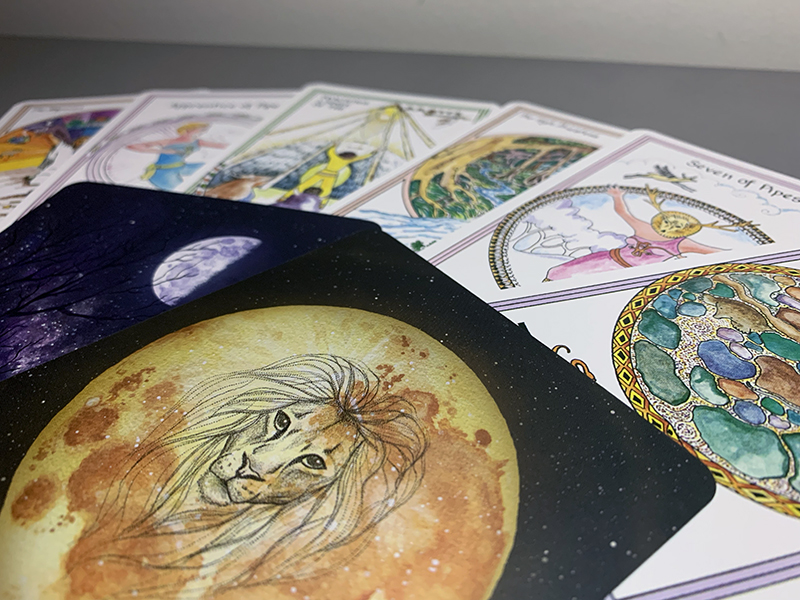
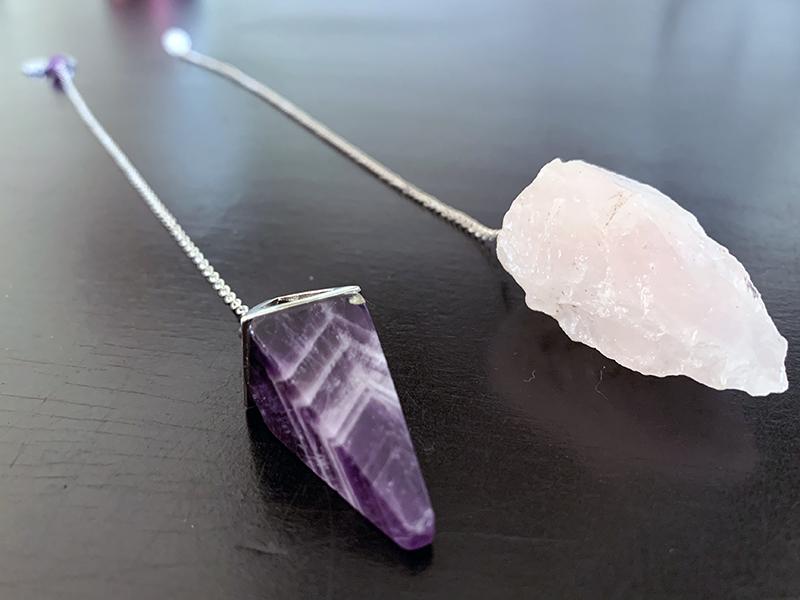
Tarot and oracle cards as well as pendulums are often used for personal guidance and self discovery. My favorite oracle deck is called Moonology and my favorite tarot deck is called the Medicine Woman. My favorite pendulums are made from amethyst and raw rose quartz. Photos by Jenna Wirth.
The New and Full Moons, otherwise known as Esbats, that make up the Lunar Year also mark important days in the Pagan calendar. Often used as a time to perform any magickal workings, many Pagans will hold lunar rituals on these dates to celebrate the Moon’s journey around the Earth. For example, every full moon, Cathy Dornton, a member of the private Facebook group Witches & Heathens of CNY that boasts 1,800 members, who has practiced Paganism for 12 years, goes outside, charges her crystals, and says the mantra “Mother of magic, mother of light, cleanse and bless my body this night” three times as she bathes in the moonlight.
Another crowd-pleaser topic we covered extensively in class was energy. Everything is energy. And based on the premise that everything is connected, magick is the act of directing energy to create change through conscious effort. And because it’s driven by intention, it will only work if someone believes it will. “Intention gives you a roadmap,” says Beverely Smith, a teacher and a High Priestess in the Druidic Craft of the Wise: The American Rite for over 20 years. “Intention shows you where you're going. If you're just out there chanting or whatever, and you have no intentions, then you're not going to get anywhere. Intention gives you a destination.” For example, if Smith wanted to make herself a money mojo bag — a flannel bag containing herbs and other magical items that helps to bring prosperity, good luck, and new opportunities into the owner’s life — she might put a little cinnamon, thyme, mint, and allspice as well as a piece of paper with her name and intentions on inside the small pouch. Then, she might dress it with certain oils and bless it.
And a working or ritual doesn't have to be super detailed. “Some people will run around the house looking for the green candle because they have to have the green candle to do the money spell and other people will just go, Fuck it, I need money, I don’t care what color the candle is, I'm doing the magick,” High Priest said. “That was a very exact description of both of our styles,” High Priest added. “Can you guess?” As much as I hated to have anything in common with High Priest, I definitely related to his school of practice. I may have anxiety and OCD, but I couldn’t give a shit about the specifics. I’ll use whatever tools I have on hand. I don’t have time to worry about the color of a candle. I’ve got more pressing issues at hand like nailing down a summer internship, planning my semester abroad next year, finding and applying for scholarships to afford college, staying on top of school work and extracurricular activities, and working as a babysitter, research assistant, and legal secretary to pay off bills and student loans.
We also learned most people lack the awareness of the universal energy that surrounds us. However, with practice, anyone can sense and, better yet, manipulate it. Various activities, including singing, chanting, dancing, and drumming, raise energy. Jen Johnson, a member of Witches & Heathens of CNY, who started practicing Paganism in high school but just most recently got back into it, describes the feeling of energy as buzz-like. “When you feel it and you tap into it and you know it's there, it's golden,” she says.
In class, we formed an energy orb in our hands to become familiar with our own energy. After rubbing my hands together for about 30 seconds, I slowly pulled them apart and visualized a small energy ball between them. As I played with the orb, I felt a tingling sensation in my hands.
Then, High Priest broke the spell, so to speak. While talking about energy, High Priest randomly mentioned to resist going to coffee shops to practice throwing energy balls at people's heads.
“Don’t do what we’ve done,” High Priestess added with a laugh.
“Hint, hint. Nudge, nudge,” High Priest said. “I wouldn't know what I’m talking about. A friend once told me that at a Spot Coffee, they practiced throwing energy balls across the room, and it wasn’t at people they knew.”
Because energy flows where attention goes, meditation serves as the foundation of energy work.
“Come on!” High Priestess said while slapping High Priest on the shoulder.
“It wasn’t me,” he said. “It wasn’t me.”
Later in class, High Priest began throwing energy balls at all of us, but nobody noticed.
“Stop it,” High Priestess said while slapping his hands. “He’s sending energy balls at all of you, just so you know. I'm telling on him.”
It was moments like these that High Priest's behavior dumbfounded me and undermined my faith in the class. Not only is he a father and husband, he’s a man-child. His actions in class reminded me of Phil Dunphy from Modern Family, but unlike Phil, he was an ass. His lame jokes erased the mystery, interest, and power of the craft, and made me realize other religions possess better spokesmodels. Christianity has Jesus. Buddhism has Buddha. Catholicism has the pope. And, sadly for me, Paganism has High Priest, whose “funny joke” did more than just cause a squabble between High Priestess and High Priest. Headset Girl shared in a later class that she had to go for a run that night to shed the excess energy bouncing around her body like a pinball machine from the powerful energy balls flung at her. And this is just one of many examples of how energy can alter people’s physical bodies. To balance energies and prevent energy burnout, Pagans must always ground and center themselves before and after taking on a magickal working. It also helps in mundane areas of life in which situations overwhelm or drain practitioners of their energy.
Despite High Priest's goofing, energy and knowing how to use it offers some daily life practicality. For example, if someone is in line to check out at a store and the person in front of them is overly angry and they’re not aware of the cloud of negativity they’re creating, they can absorb that negative energy.
To practice, we did an exercise in class to raise terrestrial energy and draw down celestial energy, creating a circuit, or two-way flow, of energy. First, I placed my feet flat on the ground, closed my eyes, and took a couple of deep breaths. As I relaxed my body (well, as much as my anxious self would allow), I started to focus on the soles of my feet. Then, as if my body were a tree, I imagined my feet digging into the ground, becoming the roots of that tree. With every breath, any energy I couldn’t handle is released through the roots and into the Earth. And as the roots traveled downward to the center of the Earth, I raised terrestrial energy up through the roots and into my body. Similarly, I envisioned branches growing from the crown of my head into the sky and into space. As the stars twinkled and pulsated in my presence, I drew celestial energy down through the branches and into my body.
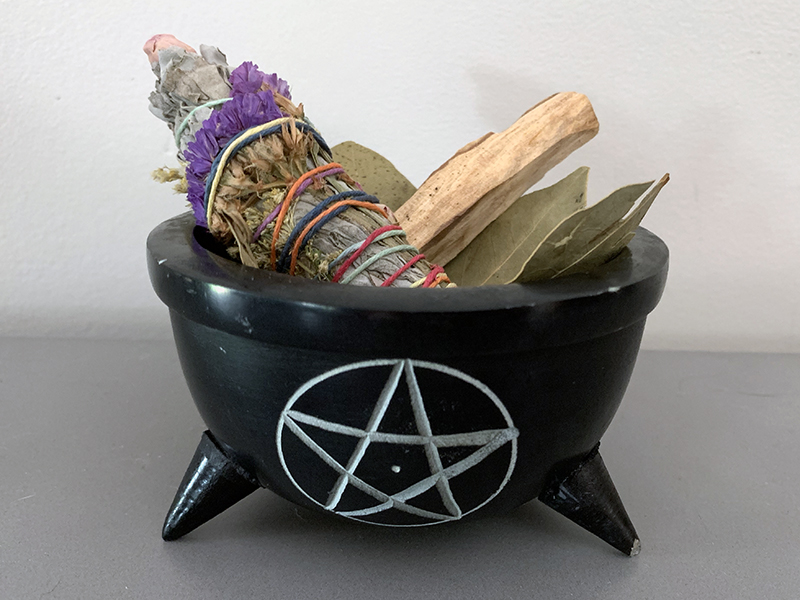
I often will write my wishes and desires on dried bay leaves and then burn them in my cauldron. I also will often burn sage to cleanse my room of negative energy as well as palo santo to attract positive energy. Photo by Jenna Wirth.
Because energy flows where attention goes, meditation serves as the foundation of energy work. It helps to tame the monkey mind, allowing the practitioner to conjure images in their mind, focus their energy, and send it out.
Elizabeth Watkin, Cherry Hill Seminary’s program coordinator, who has practiced Paganism for 25 years, describes the experience of being in the present moment as extremely peaceful. “It's almost like the world kind of stops a little bit,” she says. “You're not really thinking about what you have to do, or where you were before you got to this point. You really are just able to pay attention to your surroundings.”
In class, we performed a basic meditation in which we established our inner sanctuary, which serves as a great starting point for other magickal work. Before we began, High Priestess asked High Priest if he was going to take us through the meditation in which he exclaimed, “There’s no meditation to take them through. They figure it out for themselves. I don’t paint them the picture. It’s their picture. It’s their happy place. I'm not going to tell them what the fuck it looks like. It’s not my job.”
And, again, just like that, the entire atmosphere changed. My fellow classmates and I cringed from secondhand embarrassment, which High Priestess must have sensed because she immediately asked for us all to conjure up a place in our mind. Once we all thought of one, High Priestess instructed us to close our eyes and take a couple of deep breaths to release any tension and stress we may have in our bodies. But I don’t know how to relax. My mind wandered and stuck on the spicy Harry Potter fanfic I stumbled across last night that I could be reading and a feature story I had due in a few days that I could be writing instead of this activity as High Priestess counted down from 10. I tried to focus on what she said and indulged my imagination. Once she hit one, I saw myself standing in front of a large tree with a trunk so wide that I couldn’t reach my arms around it. As I stood in front of the tree, I noticed a double door in the bark of the tree. The doors slid open, and I stepped into an elevator. The doors closed behind me. I turned and faced the inside of the tree. The energy of the tree felt old, deep, and soothing. The elevator started to go down, and as I traveled deeper and deeper into the tree, I saw the numbers above the door count down from 10 to one. Once it hit one, the doors opened, and I stepped out of the tree and into my happy place.
Standing in my backyard, the stillness of the night sky engulfed me. In the velvet dark, yellow, orange, and green fireflies lit up the sky, begging me to chase them. Above the trees, the full moon cast a golden light onto me. Even without a telescope, I saw craters of all sizes. Mottled with light and dark patches, some bits appeared smooth, while others seemed jagged. I struggled to draw my eyes away, but High Priestess said it was time to return to the tree. Walking back, the doors slid open, and I stepped into the elevator again. As I turned around, the doors closed. Touching the inside of the tree, I said thank you for being the traveler. As High Priestess counted from one to 10, I traveled up the tree trunk, bringing me closer to consciousness.
Pagans’ intentions must always be justified too. It should be ethical. They must realize that every choice has consequences, and they must evaluate the consequences of each choice on their life and the lives of those around them. For example, when Julia Grace, a member of Covenant of the Goddess and practicing Pagan, pulls up a weed within her garden, she’s doing harm to it by killing it. “But there's a greater harm in not,” she said. “It's an invasive species. It doesn't belong here. And it's using resources that those who do belong here need for their growth and their abilities.”
Just like how there is generally no right way to practice Paganism, there is no correct way to view Deity. That said, many Pagans are polytheistic and honor multiple deities of various genders. Some Pagans choose to work within specific pantheons (often Greek, Roman, Celtic, Norse, Egyptian, and Hindu), which are groups of deities of particular ancient cultures.
Although I have absolutely no experience working with any Deity, I have always possessed an odd fascination with ancient Egypt, so maybe I’ll work with Isis or Osiris in the future. Or maybe I’ll just be agnostic. Honestly, who knows. All I know is I shouldn’t mix pantheons if I do work with multiple deities because deities have distinct personalities, and Pagans must be careful when asking them to join them during ritual. For example, although Zeus and Hera are married in Greek mythology, they hate each other. “He's a lying, cheating, son of a gun, and she hates his guts and wants to kill him every chance she gets, so if that's the energy you want to bring into your circle, please feel free to go invite them both,” High Priest said. “If you want some sort of peaceful, harmony, energetic kind of circle, don't bring both of them in. Just don’t.” Who would have thought that High Priest could be helpful? Not me.
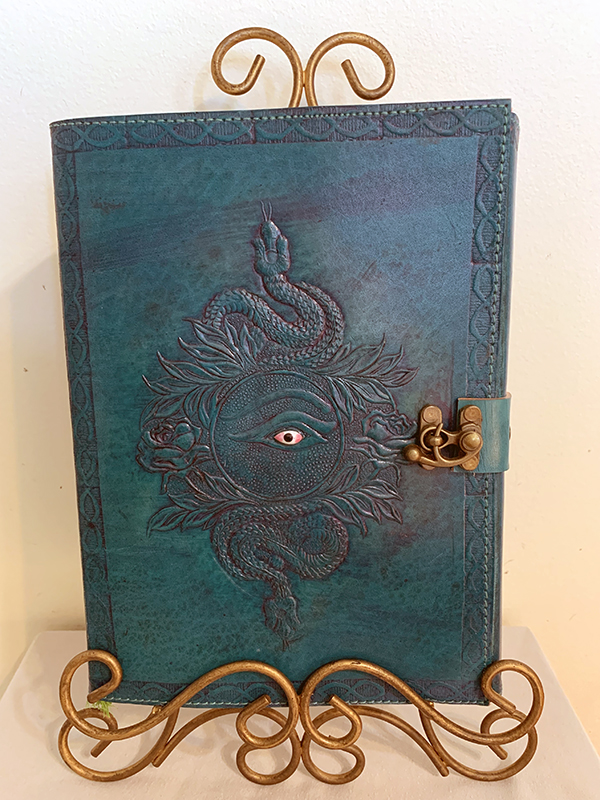
A Book of Shadows is a personal journal or diary that contains all your magickal workings, collected information, and personal thoughts. I purchased my Book of Shadows from The New Moon, a metaphysical shop in Cleveland, Ohio. Photo by Jenna Wirth.
Oftentimes, Pagans dedicate themselves to a specific God or Goddess. And by working primarily with one Deity, they develop a deep, personal relationship with that Deity. For example, Juelz Cullen, president of the nonprofit organization Witches & Heathens of CNY and owner of Julie's Cauldron in Kirkville, N.Y., who has practiced Paganism her entire life, mostly works with Hekate, the Queen of the Witches, and Pan, the God of Nature. Each Sabbat when she performs a ritual, she not only invokes the gods of the festival, but these two gods of the witches.
On the handout, it said that evocation, the act of calling Deity into one’s presence, offers one way to perform magick. When explaining this, High Priestess and High Priest started debating whether this was true.
“I would feel safe coming to Isis in a time of my heart breaking open and just bawling in front of her,” High Priestess said.
“But see, that's not magick,” High Priest replied.
“But for me it is,” she argued.
“You're using Deity’s energy as counsel, not as magick,” he responded.
Not knowing what to do, everybody just smiled awkwardly at one another through Zoom, waiting for the bickering fest to end. Shifting in my seat, all I remember thinking was: “Can we please stay on topic?”
At the end of the last class, High Priestess informed everybody that they passed the class. But, then again, I also was told there’s nothing but passing so I'm not sure that pass means much. When High Priestess asked us if we felt like we would be able to pull this off on our own, I just winced while doing the seesaw movement with my hand. They both reassured me that I will get there if I want to, and that next time I practice, I won’t have other people watching me on a computer. High Priestess also mentioned that they’ve had other students repeat the 101 class and invited us to sit in on as many classes as we would like for free. They also reminded us that the 201 class comes next, allowing us to continue to practice and access more one-on-one time with them.
I’ll pass. I signed up for Wicca 101 to grasp a better understanding of the basics of Paganism so that I could build a practice that felt true to me and that delivered me a little ownership and comfort. I longed to find a spiritual escape from the Catholicism of my youth and a balm for my soul during the pandemic. But the 10 classes left me more confused and questioning than clear-eyed and committed. But maybe that’s the case with all faiths. Humans in any equation bring flaws and egos and uncertainty, and overcoming all of that seems universal. I learned enough about how to raise and focus energy, the different cultural pantheons, and magickal tools to follow an eclectic path and do whatever I wanted, whenever I wanted.
Over the course of our class, I upped my Pagan game. I created a healing tree, purchased a leather journal to serve as my Book of Shadows, crafted a self-love spell jar, bought a wand, started using magickal oils, and even made a sigil candle that I believed helped me land an internship. As the last class ended, I, along with Smoker, The Celtic, Bandana Girl, and Headset Girl, said our goodbyes. I closed my laptop and lit a candle on my altar, and began to practice an energy ball. There was some High Priest funk that needed to be cleared.

Our pursuit of outdoor joy is remiss without the acknowledgement of the occupation of unceded Indigenous land. We are students and journalists working, writing, and living on the land of the Haudenosaunee Confederacy, comprising the Six Nations made up of the Mohawk, Onondaga, Oneida, Cayuga, Seneca, and Tuscarora nations. However, acknowledgement is not enough. Read More.